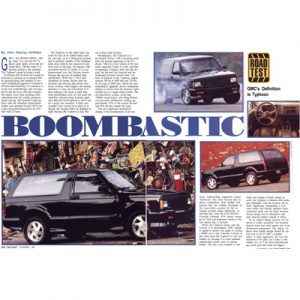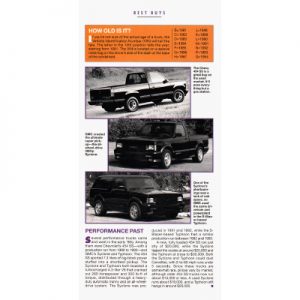Road and Track 1992 Buyers Guide

GMC SYCLONE
BY LOWELL C. PADDOCK
The English coined the term Q-ship to denote naval warships whose military mission was cloaked under the camouflage of a merchant ship. It was a dirty disguise to wear in wartime, but Q-ships were intended to catch their enemies by surprise—usually with deadly results. Such is the goal of the GMC Syclone. To the layperson, it looks like just another mini-pickup gussied up with fancy wheels and a body kit. But when the light turns green, watch out. This little monster will push back your eyeballs, compress your lunch and weaken your knees fast enough to embarrass almost any sports car in the world. And that’s saying something for a vehicle whose sticker price is little higher than a well-equipped sports coupe.
At its introduction last year, the Syclone was stirring evidence of new blood at GMC Truck, the GM division long known as an elephant’s graveyard. In recent years, GMC has been revitalized by a management team that realizes trucks have become mainstream vehicles bought by consumers who want more than just a vinyl bench and a high GVWR. To tempt these new buyers in the short run, GMC teamed up with PAS, a Detroit engineering firm, to create the Syclone using a mix of off-the-shelf powertrain technology and a devilishly modified version of GM’s 4.3-liter V-6.
From the parts bin came the viscous coupling that gives the Syclone the same full-time, all-wheel grip shared by the Oldsmobile Bravada, GMC Safari and Chevrolet Astro. On dry pavement, the system uses a 35/65 front/ rear torque split, but is capable of shuttling virtually all of the torque to whichever axle needs it most. Further grip is gained at the rear with a standard limited-slip differential.
But all that traction would hardly be fun if there wasn’t a way to exploit it. That’s the reason for endowing the 4.3 with a custom-made turbocharger and intercooler, creating a remarkable 280 bhp in the process—all in a vehicle that weighs but 2800 lb. So powerful is the engine, in fact, that PAS had to use a Corvette-based 4-speed automatic to handle its torque.
When you compare the Syclone’s power-to-weight ratio to, say, a 300ZX Turbo (which has to push around nearly 700 more lb with just 20 additional horses), you can see why the Syclone is such a deadly street warrior. In fact, a recent Rcvd & Track road test of the Syclone’s sport-utility sibling, the Typhoon, resulted in a 0-60-mph time of just 5.6 sec-1/10th of a second faster than a Corvette LT-1 and quicker than any Ferrari R&T has ever tested—save the $415,000 F40.
So, on paper at least, the Syclone’s one hell of a pickup. But is such a beast really manageable on a daily basis? Well, yes and no. Driving around town, the Syclone has a particularly annoying tendency to snap into second gear as if it were designed for the quarter- mile. At ftrst, that seems like part of the fun, but after a mile of stop-and-go traffic, it’s time to call in a good chiropractor. Once you’re past second gear, however, the turbo comes on stream and the Syclone bums up asphalt faster than an F-16.
By contrast, the Syclone’s ride quality is quite acceptable. To improve upon the Sonoma on which it is based, PAS and GMC added Bilstein shocks and 16×8 in. alloys surrounded by 245/ 50 tires to ensure sufficient grip. While the Syclone is still an S-truck at heart, the suspension mods haven’t turned it into a back breaker. As a result, there’s still a fair degree of body roll, so the Syclone may not be the autocross champion some expect it to be. Start throwing it through some tough curves and the front-biased weight distribution starts to let the tail go out. But that’s not really the point; this isn’t a truck for the everyman, after all, and the enthusiast who buys it realizes that its goal is simply to be wickedly fast—in just the way that the Buick Grand National was.
To ensure that controlling all that power is as good for the body as it is for the soul, the Syclone enjoys some pleasant interior modifications. These range from custom-designed cloth bucket seats (complete with the Syclone name embroidered on them) to a comprehensive instrument cluster adapted from the Pontiac Sunbird. Just about every S-truck option is standard, ranging from air conditioning to cruise control. In fact, the only available option is a sunroof.
To some the Syclone may seem like an expensive toy, a plaything to wow the crowds on Woodward Avenue. While that image may limit its market appeal, it nonetheless signals the fact that one American manufacturer has realized not only that trucks should be fun, but that it should go ahead and make them.
Copyright © Hachette Filipacchi Magazines. All rights reserved.
Reprint rights granted by Hachette Filipacchi New Media on January 20, 2000.





